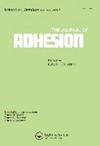胶粘剂中固化引起的应力积聚:模型建立和参数研究
IF 2.3
4区 材料科学
Q2 ENGINEERING, CHEMICAL
引用次数: 4
摘要
摘要:预测粘接接头中的应力需要很高的努力来确定相关的材料特性,这些特性在固化过程中会发生变化。此外,使用复杂粘弹性有限元(FE)模型的计算工作促进了应力积聚的有效预测。旋转和振荡流变仪可以通过测量弹性模量(MoE)和固化过程中的轴向收缩来帮助减少实验工作量。在本出版物中,为了使用有限元分析(FEA)计算固化引起的应力,在两个平行流变仪板之间对固化粘合剂的收缩、MoE的发展和泊松比进行了数值模拟。为了确定不同材料性能对应力分布的影响,进行了参数研究,并研究了不同参数的相互影响。因此,研究了粘合剂层内产生的应力和发生的变形与固化时间及其位置的关系。结果表明,最终收缩率和MoE不仅需要在最终值中考虑,还需要在收缩和反应过程中考虑。应力积聚导致流变仪板变形,在使用流变仪测定固化收缩时必须考虑这一点。本文章由计算机程序翻译,如有差异,请以英文原文为准。
Cure-induced stress build-up in adhesives: model building and parameter studies
ABSTRACT Prediction of stresses in adhesively bonded joints requires high effort in determination of relevant material properties, which change during cure. In addition, the computational effort using complex viscoelastic finite element (FE) models impends efficient prediction of stress build-up. Rotational and oscillatory rheometry can help to reduce the experimental effort by measuring of modulus of elasticity (MoE) and axial shrinkage along curing. In this publication, shrinkage, development of MoE and Poisson’s ratio of a curing adhesive were numerically modelled between two parallel rheometer plates in order to calculate cure-induced stresses using finite element analysis (FEA). To identify effects of different material properties on stress distribution, a parameter study was carried out and the reciprocal influence of the varied parameters was investigated. Consequently, resulting stresses within the adhesive layer and occurring deformations were investigated with respect to curing time as well as their location. The results showed that final shrinkage and MoE need to be considered not only in final values but also in terms of course of shrinkage and reaction. Stress build-up led to deformation of the rheometer plates, which has to be considered when using rheometry for determination of cure shrinkage.
求助全文
通过发布文献求助,成功后即可免费获取论文全文。
去求助
来源期刊

Journal of Adhesion
工程技术-材料科学:综合
CiteScore
5.30
自引率
9.10%
发文量
55
审稿时长
1 months
期刊介绍:
The Journal of Adhesion is dedicated to perpetuating understanding of the phenomenon of adhesion and its practical applications. The art of adhesion is maturing into a science that requires a broad, coordinated interdisciplinary effort to help illuminate its complex nature and numerous manifestations.
 求助内容:
求助内容: 应助结果提醒方式:
应助结果提醒方式:


